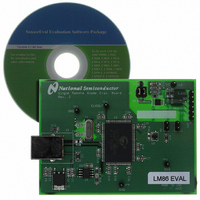LM86EVAL/NOPB National Semiconductor, LM86EVAL/NOPB Datasheet - Page 7

LM86EVAL/NOPB
Manufacturer Part Number
LM86EVAL/NOPB
Description
BOARD EVALUATION LM86
Manufacturer
National Semiconductor
Specifications of LM86EVAL/NOPB
Sensor Type
Temperature
Sensing Range
0°C ~ 125°C
Interface
SMBus (2-Wire/I²C)
Sensitivity
±1°C
Voltage - Supply
3 V ~ 3.6 V
Embedded
No
Utilized Ic / Part
LM86
Lead Free Status / RoHS Status
Lead free / RoHS Compliant
Other names
Q3975531
Note 8: Local temperature accuracy does not include the effects of self-heating. The rise in temperature due to self-heating is the product of the internal power
dissipation of the LM86 and the thermal resistance. See (Note 5) for the thermal resistance to be used in the self-heating calculation.
Note 9: Quiescent current will not increase substantially with an SMBus.
Note 10: This specification is provided only to indicate how often temperature data is updated. The LM86 can be read at any time without regard to conversion state
(and will yield last conversion result).
Note 11: Default values set at power up.
Note 12: The output rise time is measured from (V
Note 13: The output fall time is measured from (V
Note 14: Holding the SMBData and/or SMBCLK lines Low for a time interval greater than t
SMBData and SMBCLK pins to a high impedance state.
1.0 Functional Description
The LM86 temperature sensor incorporates a delta V
based temperature sensor using a Local or Remote diode
and a 10-bit plus sign ADC (Delta-Sigma Analog-to-Digital
Converter). The LM86 is compatible with the serial SMBus
version 2.0 two-wire interface. Digital comparators compare
the measured Local Temperature (LT) to the Local High
(LHS), Local Low (LLS) and Local T_CRIT (LCS) user-
programmable temperature limit registers. The measured
Remote Temperature (RT) is digitally compared to the Re-
mote High (RHS), Remote Low (RLS) and Remote T_CRIT
(RCS) user-programmable temperature limit registers. Acti-
vation of the ALERT output indicates that a comparison is
greater than the limit preset in a T_CRIT or HIGH limit
register or less than the limit preset in a LOW limit register.
The T_CRIT_A output responds as a true comparator with
built in hysteresis. The hysteresis is set by the value placed
in the Hysteresis register (TH). Activation of T_CRIT_A oc-
curs when the temperature is above the T_CRIT setpoint.
T_CRIT_A remains activated until the temperature goes be-
low the setpoint calculated by T_CRIT − TH. The hysteresis
register impacts both the remote temperature and local tem-
perature readings.
The LM86 may be placed in a low power consumption
(Shutdown) mode by setting the RUN/STOP bit found in the
Configuration register. In the Shutdown mode, the LM86’s
SMBus interface remains while all circuitry not required is
turned off.
The Local temperature reading and setpoint data registers
are 8-bits wide. The format of the 11-bit remote temperature
data is a 16-bit left justified word. Two 8-bit registers, high
and low bytes, are provided for each setpoint as well as the
temperature reading. Two offset registers (RTOLB and
RTOHB) can be used to compensate for non_ideality error,
discussed further in Section 4.1 DIODE NON-IDEALITY.
The remote temperature reading reported is adjusted by
subtracting from or adding to the actual temperature reading
the value placed in the offset registers.
1.1 CONVERSION SEQUENCE
The LM86 takes approximately 31.25 ms to convert the
Local Temperature (LT), Remote Temperature (RT), and to
update all of its registers. Only during the conversion pro-
cess the busy bit (D7) in the Status register (02h) is high.
These conversions are addressed in a round robin se-
quence. The conversion rate may be modified by the Con-
version Rate Register (04h). When the conversion rate is
modified a delay is inserted between conversions, the actual
conversion time remains at 31.25ms. Different conversion
rates will cause the LM86 to draw different amounts of
supply current as shown in Figure 2.
IN(1)
IN(0)
min - 0.15V) to (V
max + 0.15V) to (V
IN(1)
BE
IN(1)
min + 0.15V).
min − 0.15V).
7
1.2 THE ALERT OUTPUT
The LM86’s ALERT pin is an active-low open-drain output
that is triggered by a temperature conversion that is outside
the limits defined by the temperature setpoint registers. Re-
set of the ALERT output is dependent upon the selected
method of use. The LM86’s ALERT pin is versatile and will
accommodate three different methods of use to best serve
the system designer: as a temperature comparator, as a
temperature based interrupt flag, and as part of an SMBus
ALERT system. The three methods of use are further de-
scribed below. The ALERT and interrupt methods are differ-
ent only in how the user interacts with the LM86.
Each temperature reading (LT and RT) is associated with a
T_CRIT setpoint register (LCS, RCS), a HIGH setpoint reg-
ister (LHS and RHS) and a LOW setpoint register (LLS and
RLS). At the end of every temperature reading, a digital
comparison determines whether that reading is above its
HIGH or T_CRIT setpoint or below its LOW setpoint. If so,
the corresponding bit in the STATUS REGISTER is set. If the
ALERT mask bit is not high, any bit set in the STATUS
REGISTER, with the exception of Busy (D7) and OPEN
(D2), will cause the ALERT output to be pulled low. Any
temperature conversion that is out of the limits defined by the
temperature setpoint registers will trigger an ALERT. Addi-
tionally, the ALERT mask bit in the Configuration register
must be cleared to trigger an ALERT in all modes.
1.2.1 ALERT Output as a Temperature Comparator
When the LM86 is implemented in a system in which it is not
serviced by an interrupt routine, the ALERT output could be
used as a temperature comparator. Under this method of
use, once the condition that triggered the ALERT to go low is
FIGURE 2. Conversion Rate Effect on Power Supply
TIMEOUT
will reset the LM86’s SMBus state machine, therefore setting
Current
10130339
www.national.com










